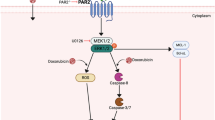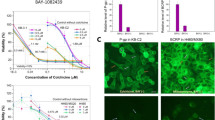Abstract
Multidrug resistance is the phenomenon by which, after exposure to a single chemotherapeutic agent, cancer cells evade the agent’s cytotoxic effects as well as become resistant to several classes of diverse drugs. ATP-binding cassette (ABC) transporters are a family of transporter proteins that contribute to drug resistance via a n ATP — dependent drug efflux pump. P-glycoprotein (P-gp) is a prominent ABC superfamily protein encoded by the mdr gene which has the ability to mediate the cellular extrusion of xenobiotics and anticancer drugs from tumor cells. Exclusively expressed P-gp cells from the human colon cancer HCT15/DOX line showed resistance to doxorubicin while parental HCT15 cells treated with doxorubicin displayed typical signs of apoptosis. In order to verify the hypothesis that expression of MDR is controlled in part, by protein kinase C (PKC), expression patterns of different PKC isoforms were examined in both cell lines. Of the PKC isoforms evaluated, the membrane translocation and expression levels of PKCα were strikingly increased in HCT15/DOX cells. PKCα reversed doxorubicin-induced apoptosis through the scavenging of ROS as well as inhibition of PARP cleavage. In addition, inhibition of PKCα with Go6976, a specific inhibitor of classical PKC, led to reduced MDR expression and increased doxorubicin-induced apoptosis. Knockdown of PKCα by siRNA diminished the protective effects of PKCα for doxorubicin-induced apoptosis. These results suggested that over-expression and activity of PKCα is closely associated with the regulation of the MDR phenotype in human colon cancer HCT15 cells and provided insight into a new strategy for inhibiting doxorubicin resistance in human cancers.
Similar content being viewed by others
References
Altenberg, G.A., Vanoye, C.G., Han, E.S., Deitmer, J.W., and Reuss, L. (1994). Relationships between rhodamine 123 transport, cell volume, and ion-channel function of P-glycoprotein. J. Biol. Chem. 269, 7145–7149.
Aquino, A., Warren, B.S., Omichinski, J., Hartman, K.D., and Glazer, R.I. (1990). Protein kinase C-gamma is present in doxorubicin resistant HL-60 leukemia cells. Biochem. Biophys. Res. Commun. 166, 723–728.
Bae, Y.S., Oh, H., Rhee, S.G., and Yoo, Y.D. (2011). Regulation of reactive oxygen species generation in cell signaling. Mol. Cells 32, 491–509.
Bose, R., Verheij, M., Haimovitz-Friedman, A., Scotto, A., Fuks, Z., and Kolesnick, R.N. (1995). Ceramide synthase mediates daunorubicin-induced apoptosis: an alternative mechanism for generating death signals. Cell 82, 405–414.
Budworth, J., Gant, T.W., and Gescher, A. (1997). Co-ordinate loss of protein kinase C and multidrug resistance gene expression in revertant MCF-7/ADR breast carcinoma cells. Br. J. Cancer 75, 1330–1335.
Clemens, M.J., Trayner, I., and Menaya, J. (1992). The role of protein kinase C isoenzymes in the regulation of cell proliferation and differentiation. J. Cell Sci. 103, 881–888.
Choi, S.U., Kim, N.Y., Choi, E.J., Kim, K.H., and Lee, C.O. (1996). Establishment of doxorubicin-resistant subline derived from HCT15 human colorectal cancer cells. Arch. Pharm. Res. 19, 342–347.
Dolfini, E., Dasdial, T., Arancia, G., Molinari, A., Calcabrini, A., Scheper, R.J., Flens, M.J., Gariboldi, M.B., and Monti, E. (1997). Characterization of a clonal human colon adenocarcinoma line intrinsically resistant to doxorubicin. Br. J. Cancer 76, 67–76.
Doroshow, J.H., Locker, G.Y., and Myers, C.E. (1980). Enzymatic defenses of the mouse heart against reactive oxygen metabolites: alter alterations produced by doxorubicin. J. Clin. Invest. 65, 128–135.
Endicott, J.A., and Ling, V. (1989). The biochemistry of P-glycoprotein mediated multidrug resistance. Ann. Rev. Biochem. 58, 137–171.
Fine, R.L., Chambers, T.C., and Sachs, C.W. (1996). P-glycoprotein, multidrug resistance and protein kinase C. Stem Cells. 14, 47–55.
Fleury, C., Mignotte, B., and Vayssiere, J.L. (2002). Mitochondrial reactive oxygen species in cell death signaling. Biochimie 84, 131–141.
Gariboldi, M.B., Ravizza, R., Riganti, L., Meschini, S., Calcabrini, A., Marra, M., Arancia, G., Dolfini, E., and Monti, E. (2003). Molecular determinants of intrinsic resistance to doxorubicin in human cancer cell lines. Int. J. Oncol. 22, 1057–1064.
Gill, P.K., Gescher, A., and Gant, T.W. (2001). Regulation of MDR1 promoter activity in human breast carcinoma cells by protein kinase C isozymes alpha and theta. Eur. J. Biochem. 268, 4151–4157.
Gottesman, M.M., and Pastan, I. (1993). Biochemistry of multidrug resistance mediated by the multidrug transporter. Annu. Rev. Biochem. 62, 385–427.
Gottesman, M., Fojo, T., and Bates, S. (2002). Multidrug resistance in cancer: role of ATP-depen dent transporters. Nat. Rev. Cancer 2, 48–58.
Gouazé, V., Mirault, M.E., Carpentier, S., Salvayre, R., Levade, T., and Andrieu-Abadie, N. (2001). Glutathione peroxidase-1 overexpression prevents ceramide production and partially inhibits apoptosis in doxorubicin-treated human breast carcinoma cells. Mol. Pharmacol. 60, 488–496.
Gravitt, K.R., Ward, N.E., Fan, D., Skibber, J.M., Levin, B., and O’Brian, C.A. (1994). Evidence that protein kinase C-alpha activation is a critical event in phorbol ester-induced multiple drug resistance in human colon cancer cells. Biochem. Pharmacol. 48, 375–381.
Han, Y., Han, Z.Y., Zhou, X.M., Shi, R., Zheng, Y., Shi, Y.Q., Miao, J.Y., Pan, B.R., and Fan, D.M. (2002). Expression and function of classical protein kinase C isoenzymes in gastric cancer cell line and its drug-resistant sublines. World J. Gastroenterol. 8, 441–445.
Inoguchi, T., Sonta, T., Tsubouchi, H., Etoh, T., Kakimoto, M., Sonoda, N., Sato, N., Sekiguchi, N., Kobayashi, K., Sumimoto, H., et al. (2003). Protein kinase C-dependent increase in reactive oxygen species (ROS) production in vascular tissues of diabetes: role of vascular NAD(P)H oxidase. J. Am. Soc. Nephrol. 14, S227–232.
Konorev, E.A., Kennedy, M.C., and Kalyanaraman, B. (1999). Cellpermeable superoxide dismutase and glutathione peroxidase mimetics afford superior protection against doxorubicin-induced cardiotoxicity: The role of reactive oxygen and nitrogen intermediates. Arch. Biochem. Biophys. 368, 421–428.
Kuranami, M., Powell, C.T., Hug, H., Zeng, Z., Cohen, A.M., and Guillem, J.G. (1995). Differential expression of protein kinase C isoforms in human colorectal cancers. J. Surg. Res. 58, 233–239.
La Porta, C.A., Dolfini, E., and Comolli, R. (1998). Inhibition of protein kinase C-alpha isoform enhances the P-glycoprotein expression and the survival of LoVo human colon adenocarcinoma cells to doxorubicin exposure. Br. J. Cancer 78, 1283–1287.
Leszczynski, D. (1995). Regulation of cell cycle and apoptosis by protein kinase C in rat myeloid leukemia cell line. Oncol. Res. 7, 471–480.
Limtrakul, P., Anuchapreeda, S., and Buddhasukh, D. (2004). Modulation of human multidrug-resistance MDR-1 gene by natural curcuminoids. BMC Cancer 4, 13.
Ling, V. (1997). Multidrug resistance: molecular mechanisms and clinical relevance. Cancer Chemother. Pharmacol. 40, S3–S8.
Lucas, M., and Sanchez-Margalet, V. (1995). Protein kinase C involvement in apoptosis. Gen. Pharmacol. 26, 886–887.
Ma, Y.Y., Wei, S.J., Lin, Y.C., Lung, J.C., Chang, T.C., Whang-Peng, J., Liu, J.M., Yan, D.M., Yang, W.K., and Shen, C.Y. (2000). PIK3CA as an oncogene in cervical cancer. Oncogene 19, 2739–2744.
Mellor, H., and Parker, P.J. (1998). The extended protein kinase C superfamily. Biochem. J. 332, 281–292.
Nakura, A., Higuchi, C., Yoshida, K., and Yoshikawa, H. (2011). PKCα suppresses osteoblastic differentiation. Bone 48, 476–484.
Nishizuka, Y., and Kikkawa, U. (2003). Early studies of protein kinase C: a historical perspective. Methods Mol. Biol. 233, 9–18.
O’Brian, C.A., Ward, N.E., Stewart, J.R., and Chu, F. (2001). Prospects for targeting protein kinase C isozymes in the therapy of drug resistant cancer—an evolving story. Cancer Met. Rev. 20, 95–100.
Osborn, M.T., Berry, A., Ruberu, M.S., Ning, B.T., Bell, L.M., and Chambers, T.C. (1999). Phorbol ester induced MDR1 expression in K562 cells occurs independently of mitogen-activated protein kinase signaling pathways. Oncogene 18, 5756–5764.
Ruvolo, P.P., Deng, X., Carr, B.K., and May, W.S. (1998). A functional role for mitochondrial protein kinase Calpha in Bcl2 phosphorylation and suppression of apoptosis. J. Biol. Chem. 273, 25436–25442.
Skladanowski, A., and Konopa, J. (1993). Doxorubicin and daunomycin induce programmed cell death (apoptosis) in tumour cells. Biochem. Pharmacol. 46, 375–382.
Takara, K., Sakaeda, T., and Okumura, K. (2006). An update on overcoming MDR1-mediated multidrug resistance in cancer chemotherapy. Curr. Pharm. 12, 273–228.
Tentori, L., Portarena, I., Bonmassar, E., and Graziani, G. (2001). Combined effects of adenovirus-mediated wild-type p53 transduction, temozolomide and poly (ADP-ribose) polymerase inhibitor in mismatch repair deficient and non-proliferating tumor cells. Cell Death Differ. 8, 457–469.
Wang, N., Li, Z., Tian, F., Feng, Y., Huang, J., Li, C., and Xie, F. (2010). PKCα inhibited apoptosis by decreasing the activity of JNK in MCF-7/ADR cells. Exp. Toxicol. Pathol. 64, 459–464.
Yu, G., Ahmad, S., Aquino, A., Fairchild, C.R., Tepel, J.B., Ohno, S., Suzuki, K., Tsuro, T., Cowan, K.H., and Glazer, R.I. (1991). Transfection with protein kinase C confers increased multidrug α resistance to MCF-7 cells expressing P-glycoprotein. Cancer Commun. 3, 181–189.
Author information
Authors and Affiliations
Corresponding author
About this article
Cite this article
Lee, SK., Shehzad, A., Jung, JC. et al. Protein kinase Cα protects against multidrug resistance in human colon cancer cells. Mol Cells 34, 61–69 (2012). https://doi.org/10.1007/s10059-012-0087-1
Received:
Revised:
Accepted:
Published:
Issue Date:
DOI: https://doi.org/10.1007/s10059-012-0087-1




